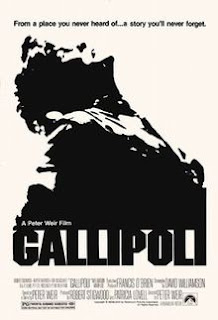 |
| Gallipoli (1981 film) |
The development of social history in the 1970s revolutionised the ways in which stories about war were told. In Australia, historians wrote new military histories that illuminated the experiences of ordinary soldiers. Titles such as The Broken Years: Australian Soldiers in the Great War (1974) by Bill Gammage and The Anzacs by Patsy Adam Smith (1978) drew heavily from soldiers’ diaries and letters, injecting the historical genre with new life. They also provided a foundation from which to create new fictional works. Peter Weir has cited The Broken Years as a key text when writing the 1981 blockbuster film, 'Gallipoli’, hiring Gammage to work on set as a historical consultant.
Over the past twenty years, Australians have developed an insatiable appetite for all things Anzac. Military history is big business. Australians read books about Anzac history, watch documentaries and films, visit museums and overseas battlefields, and attend commemorative events such as the AFL Anzac Day Clash. Few of these projects involve academic historians. Why?
Popular narratives of war are beset with intense human drama and emotion, yet tend to fall into comfortable dichotomies of right and wrong. The heroes and villains of past wars are easily recognisable, offering reassurance in a world comprised of shades of grey. While exposing us to the worst of humanity, perhaps we also feel it celebrates the best? Bookshelves and cinemas are dominated by stories of heroism and sacrifice. Do tales of risk and adventure hold a particular appeal to those who wish to escape the sanitised and structured boundaries of modern life? Paradoxically then, the search for ‘authenticity’ leads consumers into imagined worlds. The terrible dichotomies of war provide us with a satisfying catharsis, allowing us to express anger and grief, yet ultimately entertains us - offering a range of exciting and compelling stories.
Not only have the types of stories we tell about war changed, we have developed new ways to tell them. Television, documentaries, film, publishing and tourism convey history with vivid realism, employing evocative imagined sights and sounds. Alison Landsburg argues that “the modern marketplace has developed an unprecedented ability to create and disseminate evocative, hyper-real, representations of the past to large numbers of people who did not experience these events for themselves”(1).
Military history is the best-selling genre of historical writing in Australia, yet remains unpopular with historians, many of whom feel uncomfortable with the kinds of narratives disseminated by consumer culture. Michelle Arrow has recognised that “the sense of emotional connection popular histories aim to evoke – the idea that the viewer can know what those in the past thought and felt – runs counter to most historians’ notions of historical understanding”(2).
Today, most best selling military histories are written by journalists and amateur historians, yet professional scholars have shown signs of re-entering this territory. In 2012, historian Bruce Scates published On Dangerous Ground: A Gallipoli Story, a fictional account of the Gallipoli campaign based on robust historical research. With the Anzac Centenary looming, I hope others follow his lead.
Footnotes:
(1) Alison Landsberg, Prosthetic Memory: The Transformation of American Remembrance in the Age of Mass Culture, New York: Columbia University Press, 2004.
(2) Michelle Arrow, 'The Making History initiative and Australian popular history', Rethinking History: The Journal of Theory and Practice, Vol 15, No. 2, 2011, p.154.